- 1Université Paris-Saclay, CNRS/IN2P3, IJCLab, Orsay, France
- 2Facility for Rare Isotope Beams, Michigan State University, East Lansing, MI, United States
- 3Department of Physics and Astronomy, Michigan State University, East Lansing, MI, United States
A systematic study of parametric uncertainties in transfer reactions is performed using the recently developed uncertainty quantified global optical potential (KDUQ). We consider reactions on the doubly-magic spherical nucleus 48Ca and explore the dependence of the predicted
1 Introduction
Transfer reactions are widely used in nuclear experimental studies, either for extracting astrophysical information that cannot be obtained directly or for studying properties of the nucleus of interest (e.g., Refs. [1–11]). However, reaction theory is essential to interpret transfer reactions measurements [12, 13]. The properties we wish to extract from transfer reactions, such as spectroscopic factors (SF), asymptotic normalization coefficients (ANC) or neutron capture rates, depend strongly on the normalization of the transfer cross section while the model used to describe the reaction carries uncertainties that affect the normalization [12]. Thus, for a reliable interpretation of transfer measurements, it is crucial that we understand the uncertainties associated with the theory.
In this work we focus on
In the last few years, many studies have been performed to quantify the uncertainty in
Moreover, Ref. [21] studies the uncertainties coming from the single-particle potential that binds the neutron in the final state in
The recent development of an uncertainty-quantified global optical model (KDUQ) [25], based on the original work [26], provides another avenue to study the uncertainties in reactions. Propagating the parametric uncertainties from KDUQ to reaction observables has been done for specific cases (e.g., for knockout and transfer [27, 28] and charge-exchange [24]). In general, the uncertainties due to optical potentials in reaction observables can be influenced by many different details of the reaction process [29, 30]. Due to strong non-linearities in the reaction model, it is important to study these uncertainties more systematically to understand the impact of correlations in optical potential parameters and whether there are general features that emerge. KDUQ provides a unified effective framework to perform this study.
This work is a systematic study of the uncertainties associated with the optical potentials in transfer
2 A brief summary of the theory used
2.1 Reaction theory
The finite-range ADWA [14] starts out by considering a full three-body picture for the transfer reaction
In Equation 1,
where
More details about the ADWA and how to obtain numerical solutions for bound and scattering states can be found in Ref. [31]. In this work, we use the code NLAT [15] to perform all ADWA transfer calculations and the code FRESCO [32] to perform the elastic scattering calculations.
2.2 Statistical model
As mentioned in Section 1, we use the global optical potentials KDUQ [25] for all nucleon-nucleus interactions needed in the reaction model of Section 2.1, which is valid for
The test case we focus on is based on the 48Ca
It must be underlined that KDUQ posterior distributions contain no constraints from bound state data. Our assumption is to consider that the geometry of the mean field generated by the target nucleus does not change considerably from bound to scattering states. This is consistent with the KDUQ assumption, since it uses an energy-independent parametrization for the radius and diffuseness of the real term, and these parameters are well constrained by the Bayesian calibration. When using 416 samples for the real radius and diffuseness of KDUQ and refitting the real depth to reproduce the correct neutron separation energy (KDUQ-real). The resulting ANC-squared
3 Results
3.1 The physical 48Ca (d,p)49Ca (g.s) reaction
Optical potentials are determined primarily from observables that are sensitive to the on-shell T-matrix. Transfer observables are also sensitive to properties of the T-matrix off-shell. It is thus not guaranteed, even if the optical potentials reproduce the corresponding elastic channels, that they describe the transfer data. Using the reaction 48Ca
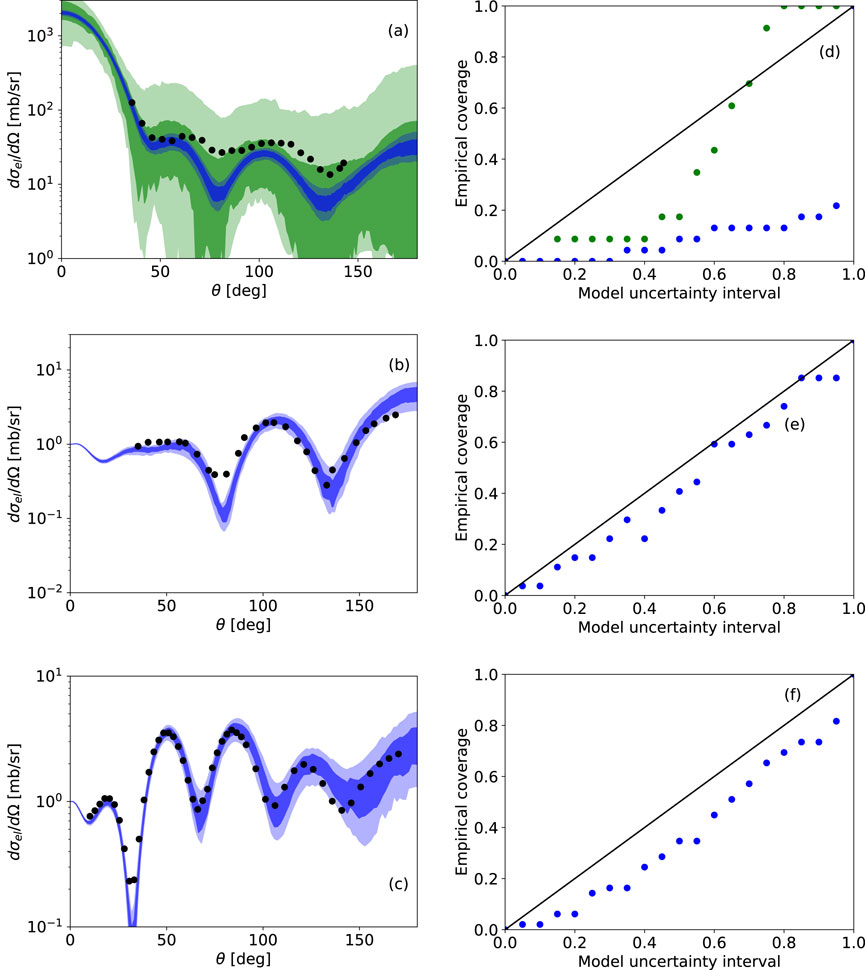
Figure 1. Angular distributions for the elastic scattering of (A)
The empirical coverage provides a sanity check for uncertainty quantification. Our empirical coverages for a x% model uncertainty are calculated as the number of data points, including a x% experimental error, that fall into the theoretical x% credible interval divided by the total number of data points in an angular distribution. These are shown in Figures 1D–F for the corresponding three elastic scattering examples. In an ideal situation, the predicted empirical coverage should line up with the black diagonal line4. In our calculations for proton elastic scattering, empirical coverages calculated at the high-confidence level are only slightly underestimated. However, for neutron scattering, there is a severe mismatch. This suggests that, in this case, the error on the data [40] and/or on the KDUQ parameters are seriously under-reported. To include unaccounted-for uncertainties, we have inflated the width of the posterior distributions of the depths, radii and diffuseness of the neutron-target potential, so that we can reproduce the correct empirical coverage specifically for
We now use these parameter posterior distributions and propagate the uncertainties to the 48Ca
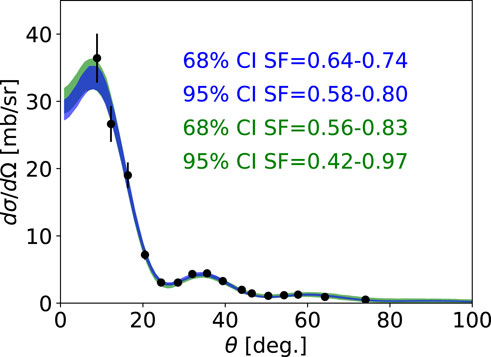
Figure 2. Angular distribution for 48Ca
The theoretical predictions for
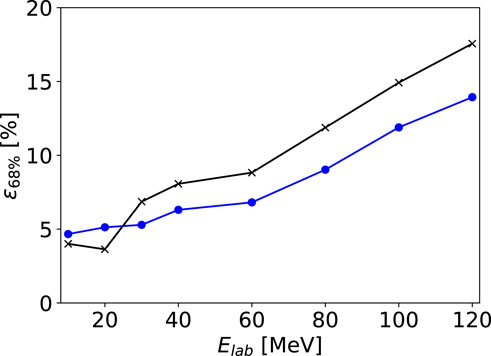
Figure 3. Relative half-width
To complement our analysis, we also study the uncertainties associated with the single-particle potential used to generate the final bound state. We quantify its uncertainties using the geometry of the real part of the KDUQ interaction (KDUQ-real), as discussed in Section 2.2. We consider various cases in Table 1 for which we compute the relative half-widths of the transfer angular distribution

Table 1. Relative half-width
Then, we evaluate the uncertainties due to the choice of single-particle potentials, using the geometry of the real volume term of 416 KDUQ and KDUQ-n samples. In the KDUQ case, the uncertainty half-widths
Having established a realistic foundation for the uncertainty estimates of the angular distributions of the 48Ca
3.2 Uncertainties in transfer reactions with beam energy
We first analyze the dependence of the uncertainties on the beam energy. For this study, we keep the final bound state fixed using the STD single-particle geometry as described in Section 3.1, and take all optical potential posteriors from the original KDUQ parametrization. The relative half-width
We first consider ADWA calculations using all three optical potentials derived consistently from the same KDUQ sample (blue line). We find that the relative half-width
To investigate the importance of correlations in the uncertainties of the optical potentials, we consider ADWA calculations using optical potentials derived from different KDUQ samples (black line). For almost all beam energies, the relative uncertainties are slightly larger than in the previous results, where all potentials were derived consistently from the same KDUQ sample. At the highest beam energies studied, the shift in
3.3 Dependence on the properties of the final bound state
Next, we consider the effects of different properties of the final bound state, namely, the dependence of the uncertainty with the r.m.s Radius squared
We first consider the effect of the single-particle potential radius
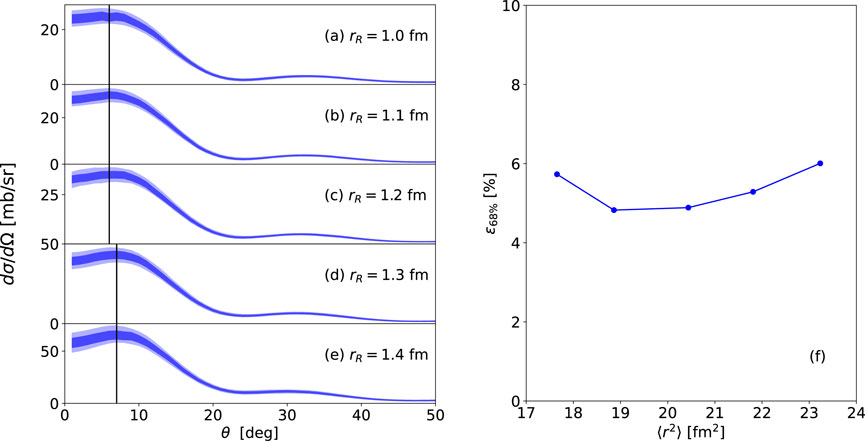
Figure 4. (a–e) Transfer angular distributions for 48Ca
We find that the diffraction pattern of the transfer angular distributions do not change significantly with radius. Expectedly, the magnitude of the transfer cross section increases with the single-particle potential radius
Next, we consider the dependence on the separation energy of the final state, of the uncertainty for the transfer cross section due to the optical potentials. We fix the STD geometry for the neutron single-particle potential to the original values (
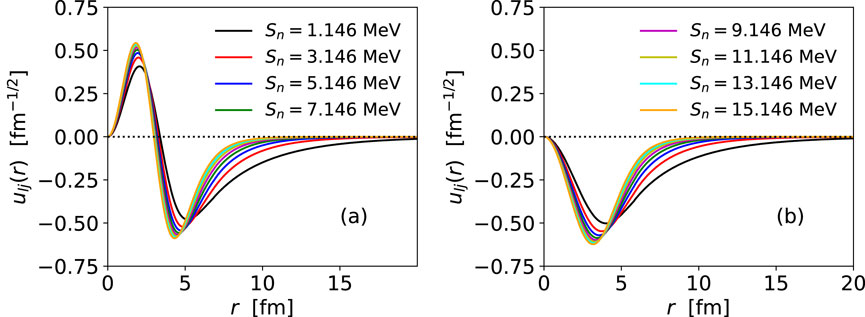
Figure 5. 48Ca s. p. Wave function for a

Figure 6. Transfer angular distributions for 48Ca
The resulting relative half-width
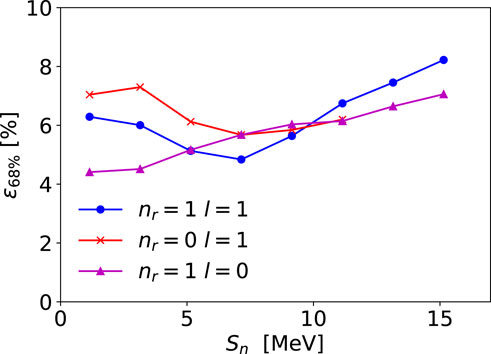
Figure 7. Relative half-widths
4 Conclusion
In this work, we perform a systematic study of parametric uncertainties in
By first analyzing a realistic case, we show that for proton scattering off the doubly-magic spherical nucleus 48Ca, the elastic-scattering cross sections predicted with the KDUQ global optical potential reproduce well the available scattering data. The empirical coverage lies close to the ideal case, i. e., the diagonal, demonstrating the reliability of the uncertainty estimates of the KDUQ optical potential. However, KDUQ does not reproduce well the neutron scattering data on 48Ca, suggesting that either the error on the data are seriously under-reported or the uncertainties of KDUQ are unrealistically small. To account for this, we rescale the KDUQ posterior to obtain an ideal empirical coverage at the
Then fixing the geometry of the single-particle potentials and considering the same KDUQ posterior distribution, we investigate how the uncertainties in transfer observables are influenced by the beam energy of the reaction and the properties of the final bound state. Since the same KDUQ posterior parameters are taken in all cases, the different uncertainties do not come from the evolution of KDUQ uncertainties across nuclei or with the beam energy, but are a direct consequence on how uncertainties propagate through the model differently, depending on the details of the reaction.
We show that at higher beam energy, the uncertainties in transfer observables increase. This is a direct consequence of the radial range probed by transfer reactions at various beam energies: transfer reactions at higher beam energies are more sensitive to the short-range part of the T-matrix, which is not well constrained for optical potentials fitted on elastic observables. We find that the correlations in the optical potentials used to generate the scattering states can change the uncertainty estimate by
We also investigate how uncertainties due to optical potentials depend on the properties of the final bound state: we vary the geometry of the single-particle potential, the binding energy, the orbital angular momentum and the number of nodes. As expected, the magnitude and the shape of the transfer cross sections change, as they are influenced by the spatial extension of the bound-state wave function, its orbital angular momentum and the
Although our results are quite general, there were important simplifying assumptions that should be kept in mind. First, our analysis does not account for uncertainties associated with the ADWA approximation to the three-body dynamics. In particular, the neglect of the remnant term is likely to become inaccurate for reactions on light nuclei or populating halo final states. Second, we use the same KDUQ posterior distributions for all cases. This assumption likely leads to an underestimation of parametric uncertainties for transfer reactions at higher beam energies, since KDUQ’s relative uncertainties are larger at higher energy (as illustrated in the volume integral in Figure 13 of Ref; [25]). Finally, the KDUQ posterior distribution we chose is likely unrealistic for nuclei with low separation energies, since these isotopes are far from the valley of stability. No data on unstable nuclei or deformed nuclei were included in the calibration of KDUQ and, therefore, one expects the uncertainties to grow substantially as we move to more exotic territory.
This systematic study enables us to draw three important take-away points. First, for well constrained potentials, such as KDUQ, small uncertainties in transfer observables can be expected, typically around 5%–10%. Second, there are significant correlations between the single-particle potential and optical potential parameters that impact the estimated uncertainties on the transfer. This argues for a framework where bound state data and scattering data can both be used to constrain the same interaction consistently, something that is obtained by imposing the dispersive relation [43]. We should expect that, because in the dispersive optical model bound state data is used to the potential, it may lead to a better constrained off-shell part of the T-matrix, hence reducing the uncertainties on reaction observables that do not solely depend on the on-shell properties (such as elastic scattering). Third, our results show that the relative uncertainty estimates of transfer angular distributions are not sensitive to detailed properties of the neutron orbital in the final state populated by the transfer reaction.
Data availability statement
The raw data supporting the conclusions of this article will be made available by the authors, without undue reservation.
Author contributions
CH: Conceptualization, Data curation, Formal analysis, Investigation, Software, Visualization, Writing – original draft, Writing – review and editing. FN: Conceptualization, Formal analysis, Investigation, Writing – original draft, Writing – review and editing.
Funding
The author(s) declare that financial support was received for the research and/or publication of this article. The work of FN was in part supported by the U.S. Department of Energy grant DE-SC0021422 and National Science Foundation CSSI program under award No. OAC-2004601 (BAND Collaboration).
Acknowledgments
CH and FN. thank Kyle Beyer, Manuel Catacora-Rios, Garrett King and other members of the few-body reaction group at MSU for their careful reading of the manuscripts and their comments. CH thanks Cole Pruitt and Gregory Potel for interesting discussions regarding the results of this work. We gratefully acknowledge computational support from iCER at Michigan State University.
Conflict of interest
The authors declare that the research was conducted in the absence of any commercial or financial relationships that could be construed as a potential conflict of interest.
The handling editor BK declared a past co-authorship with the author CH.
Generative AI statement
The author(s) declare that no Gen AI was used in the creation of this manuscript.
Publisher’s note
All claims expressed in this article are solely those of the authors and do not necessarily represent those of their affiliated organizations, or those of the publisher, the editors and the reviewers. Any product that may be evaluated in this article, or claim that may be made by its manufacturer, is not guaranteed or endorsed by the publisher.
Footnotes
1We also consider the federal version of KDUQ [25], in which each data type is given equal weight on the overall likelihood. Using the federal KDUQ, we obtained transfer angular distributions exhibiting similar uncertainties as the ones obtained with the democratic KDUQ
2The uncertainties of this data set are not clearly reported. We consider a 10% relative error per data point, which is a typical error for transfer data on stable nuclei
3The x% credible intervals are computed as the smallest interval that include x% of the cross section predicted by the 416 samples of KDUQ
4All results in blue in Figure 1 correspond to the uncertainties from KDUQ when the data protocol is democratic [25].
5We do not compute transfer cross sections beyond
References
1. Kay BP, Schiffer JP, Freeman SJ. Quenching of cross sections in nucleon transfer reactions. Phys Rev Lett (2013) 111:042502. doi:10.1103/physrevlett.111.042502
2. Avila ML, Rogachev GV, Koshchiy E, Baby LT, Belarge J, Kemper KW, et al. Constraining the 6.05 MeV 0+ and 6.13 MeV 3− cascade transitions in the 12C(α,γ)16O reaction using the asymptotic normalization coefficients. Phys Rev Lett (2015) 114:071101. doi:10.1103/physrevlett.114.071101
3. Walter D, Pain SD, Cizewski JA, Nunes FM, Ahn S, Baugher T, et al. Constraining spectroscopic factors near the r-process path using combined measurements: 86Kr (d,p)87Kr. Phys Rev C (2019) 99:054625. doi:10.1103/physrevc.99.054625
4. Salathe M, Crawford HL, Macchiavelli AO, Kay BP, Hoffman CR, Ayangeakaa AD, et al. Search for the 1/2+ intruder state in 35P. Phys Rev C (2020) 102:064317. doi:10.1103/physrevc.102.064317
5. Lalanne L, Sorlin O, Assié M, Hammache F, de Séréville N, Koyama S, et al. Evaluation of the 35K(p,γ)36Ca reaction rate using the 37Ca(p,d)36Ca transfer reaction. Phys Rev C (2021) 103:055809. doi:10.1103/PhysRevC.103.055809
6. Hammache F, de Sereville N. Transfer reactions as a tool in nuclear astrophysics. Front Phys (2021) 8:2020. doi:10.3389/fphy.2020.602920
7. Kay BP, Tang TL, Tolstukhin IA, Roderick GB, Mitchell AJ, Ayyad Y, et al. Quenching of single-particle strength in A = 15 nuclei. Phys Rev Lett (2022) 129:152501. doi:10.1103/physrevlett.129.152501
8. Lalanne L, Sorlin O, Poves A, Assié M, Hammache F, Koyama S, et al. Structure of 36Ca under the coulomb magnifying glass. Phys Rev Lett (2022) 129:122501. doi:10.1103/physrevlett.129.122501
9. Jones KL, Bey A, Burcher S, Allmond JM, Galindo-Uribarri A, Radford DC, et al. Neutron transfer reactions on the ground state and isomeric state of a 130Sn beam. Phys Rev C (2022) 105:024602. doi:10.1103/physrevc.105.024602
10. Bennett SA, Garrett K, Sharp DK, Freeman SJ, Smith AG, Wright TJ, et al. Direct determination of fission-barrier heights using light-ion transfer in inverse kinematics. Phys Rev Lett (2023) 130:202501. doi:10.1103/physrevlett.130.202501
11. Hebborn C, Avila ML, Kravvaris K, Potel G, Quaglioni S. Impact of the 6Li asymptotic normalization constant onto α-induced reactions of astrophysical interest. Phys Rev C (2024) 109:L061601. doi:10.1103/physrevc.109.l061601
12. Nunes F, Potel G, Poxon-Pearson T, Cizewski J. Nuclear reactions in astrophysics: a review of useful probes for extracting reaction rates. Annu Rev Nucl Part Sci (2020) 70:147–70. doi:10.1146/annurev-nucl-020620-063734
13. Timofeyuk NK, Johnson RC. Theory of deuteron stripping and pick-up reactions for nuclear structure studies. Prog Part Nucl Phys (2020) 111:103738. doi:10.1016/j.ppnp.2019.103738
14. Johnson RC, Tandy PC. An approximate three-body theory of deuteron stripping. Nucl Phys A (1974) 235:56–74. doi:10.1016/0375-9474(74)90178-x
15. Titus LJ, Ross A, Nunes FM. Transfer reaction code with nonlocal interactions. Comput Phys Commun (2016) 207:499–517. doi:10.1016/j.cpc.2016.06.022
16. Nunes FM, Deltuva A. Adiabatic approximation versus exact faddeev method for (d, p) and (p, d) reactions. Phys Rev C (2011) 84:034607. doi:10.1103/physrevc.84.034607
17. Upadhyay NJ, Deltuva A, Nunes FM. Testing the continuum-discretized coupled channels method for deuteron-induced reactions. Phys Rev C (2012) 85:054621. doi:10.1103/physrevc.85.054621
18. Lovell AE, Nunes FM. Constraining transfer cross sections using bayes’ theorem. Phys Rev C (2018) 97:064612. doi:10.1103/physrevc.97.064612
19. King GB, Lovell AE, Nunes FM. Uncertainty quantification due to optical potentials in models for (d, p) reactions. Phys Rev C (2018) 98:044623. doi:10.1103/physrevc.98.044623
20. Lovell AE, Nunes FM, Catacora-Rios M, King GB. Recent advances in the quantification of uncertainties in reaction theory. J Phys G: Nucl Part Phys (2020) 48:014001. doi:10.1088/1361-6471/abba72
21. Catacora-Rios M, Lovell AE, Nunes FM. Complete quantification of parametric uncertainties in (d, p) transfer reactions. Phys Rev C (2023) 108:024601. doi:10.1103/physrevc.108.024601
22. Pruitt CD, Lovell AE, Hebborn C, Nunes FM. The role of the likelihood for elastic scattering uncertainty quantification. Phys Rev C (2024) 110:064606. doi:10.1103/PhysRevC.110.064606
23. Whitehead TR, Poxon-Pearson T, Nunes FM, Potel G. Prediction for (p, n) charge-exchange reactions with uncertainty quantification. Phys Rev C (2022) 105:054611. doi:10.1103/physrevc.105.054611
24. Smith AJ, Hebborn C, Nunes FM, Zegers RGT. Uncertainty quantification in (p, n) reactions. Phys Rev C (2024) 110:034602. doi:10.1103/physrevc.110.034602
25. Pruitt CD, Escher JE, Rahman R. Uncertainty-quantified phenomenological optical potentials for single-nucleon scattering. Phys Rev C (2023) 107:014602. doi:10.1103/physrevc.107.014602
26. Koning A, Delaroche J. Local and global nucleon optical models from 1 keV to 200 MeV. Nucl Phys A (2003) 713:231–310. doi:10.1016/s0375-9474(02)01321-0
27. Hebborn C, Nunes FM, Lovell AE. New perspectives on spectroscopic factor quenching from reactions. Phys Rev Lett (2023) 131:212503. doi:10.1103/physrevlett.131.212503
28. Hebborn C, Nunes FM, Lovell AE. Erratum: new perspectives on spectroscopic factor quenching from reactions. Phys Rev Lett (2024) 132:139901. doi:10.1103/physrevlett.132.139901
29. Hebborn C, Whitehead TR, Lovell AE, Nunes FM. Quantifying uncertainties due to optical potentials in one-neutron knockout reactions. Phys Rev C (2023) 108:014601. doi:10.1103/PhysRevC.108.014601
30. Hebborn C, Nunes FM, Potel G, Dickhoff WH, Holt JW, Atkinson MC, et al. Optical potentials for the rare-isotope beam era. J Phys G: Nucl Part Phys (2023) 50:060501. doi:10.1088/1361-6471/acc348
32 . Thompson IJ. Coupled reaction channels calculations in nuclear physics. Comp Phys Rep (1988) 7:167–212. doi:10.1016/0167-7977(88)90005-6
33. Mukhamedzhanov AM, Nunes FM, Mohr P. Benchmark on neutron capture extracted from (d, p) reactions. Phys Rev C (2008) 77:051601. doi:10.1103/PhysRevC.77.051601
34. Rapaport J, Sperduto A, Salomaa M. Analysis of the 48Ca(d,p)49Ca reaction for incident energies below and above the coulomb barrier. Nucl Phys A (1972) 197:337–51. doi:10.1016/0375-9474(72)91015-9
35. Metz WD, Callender WD, Bockelman CK. Forbidden transitions in the 48Ca(d,p)49Ca reaction. Phys Rev C (1975) 12:827–44. doi:10.1103/PhysRevC.12.827
36. Uozumi Y, Iwamoto O, Widodo S, Nohtomi A, Sakae T, Matoba M, et al. Single-particle strengths measured with 48Ca(d,p)49Ca reaction at 56 mev. Nucl Phys A (1994) 576:123–37. doi:10.1016/0375-9474(94)90740-4
37. Walter D, Pain SD, Cizewski JA, Nunes FM, Ahn S, Baugher T, et al. Constraining spectroscopic factors near the r-process path using combined measurements: 86Kr (d,p)87Kr. Phys Rev C (2019) 99:054625. doi:10.1103/PhysRevC.99.054625
38. Sürer O, Nunes FM, Plumlee M, Wild SM. Uncertainty quantification in breakup reactions. Phys Rev C (2022) 106:024607. doi:10.1103/PhysRevC.106.024607
39. Fernandes JC, Crespo R, Nunes FM. How unique is the asymptotic normalization coefficient method? Phys Rev C (2000) 61:064616. doi:10.1103/PhysRevC.61.064616
40. Mueller JM, Charity RJ, Shane R, Sobotka LG, Waldecker SJ, Dickhoff WH, et al. Asymmetry dependence of nucleon correlations in spherical nuclei extracted from a dispersive-optical-model analysis. Phys Rev C (2011) 83:064605. doi:10.1103/physrevc.83.064605
41. Lombardi JC, Boyd RN, Arking R, Robbins AB. Nuclear sizes in 40,44,48Ca. Nucl Phys A (1972) 188:103–14. doi:10.1016/0375-9474(72)90186-8
42. McCamis RH, Nasr TN, Birchall J, Davison NE, van Oers WTH, Verheijen PJT, et al. Elastic scattering of protons from 40,42,44,48Ca from 20 to 50 MeV and nuclear matter radii. Phys Rev C (1986) 33:1624–33. doi:10.1103/physrevc.33.1624
Keywords: nuclear reactions, optical model, single-nucleon transfer reactions, uncertainty quantification, single-particle properties
Citation: Hebborn C and Nunes FM (2025) Systematic study of the propagation of uncertainties to transfer observables. Front. Phys. 13:1525170. doi: 10.3389/fphy.2025.1525170
Received: 08 November 2024; Accepted: 07 May 2025;
Published: 05 June 2025.
Edited by:
Benjamin Kay, Argonne National Laboratory (DOE), United StatesReviewed by:
Stefano Burrello, Laboratori Nazionali del Sud (INFN), ItalyMalte Albrecht, Jefferson Lab (DOE), United States
Copyright © 2025 Hebborn and Nunes. This is an open-access article distributed under the terms of the Creative Commons Attribution License (CC BY). The use, distribution or reproduction in other forums is permitted, provided the original author(s) and the copyright owner(s) are credited and that the original publication in this journal is cited, in accordance with accepted academic practice. No use, distribution or reproduction is permitted which does not comply with these terms.
*Correspondence: C. Hebborn, aGViYm9ybkBpamNsYWIuaW4ycDMuZnI=
 C. Hebborn
C. Hebborn F. M. Nunes
F. M. Nunes